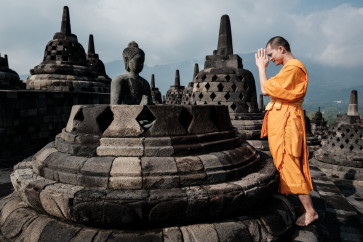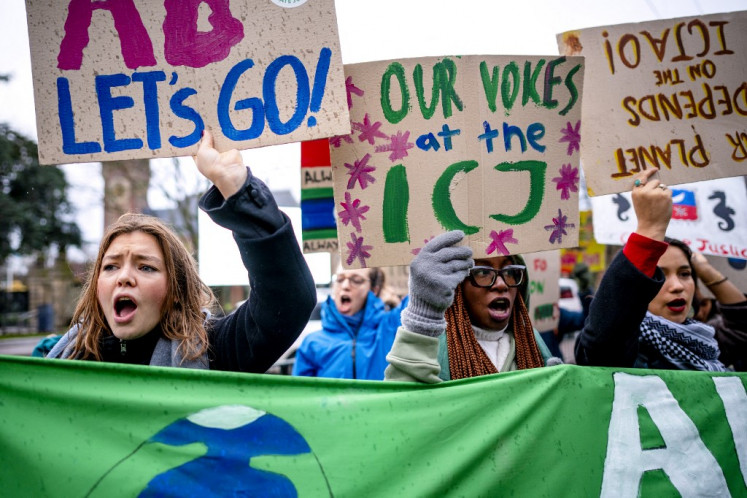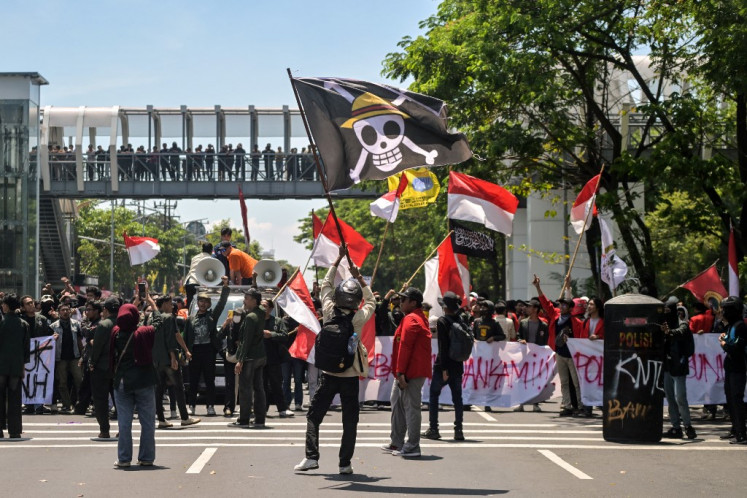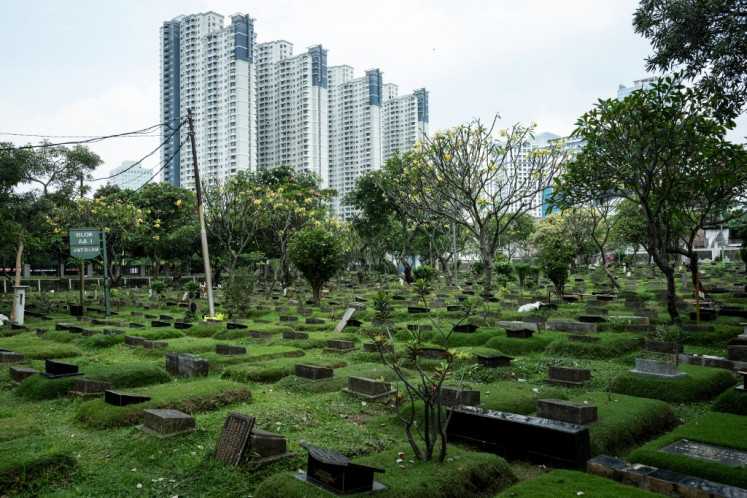Popular Reads
Top Results
Can't find what you're looking for?
View all search resultsPopular Reads
Top Results
Can't find what you're looking for?
View all search resultsWhere were the women in 212 protest?
The protest structurally and systematically rejected the presence of Muslim women within its circle of narrative. Structurally speaking, the protest was centered on the Friday prayer, a specific kind of public worship in which Muslim women not only in Indonesia but also around the world are discouraged from attending.
Change text size
Gift Premium Articles
to Anyone
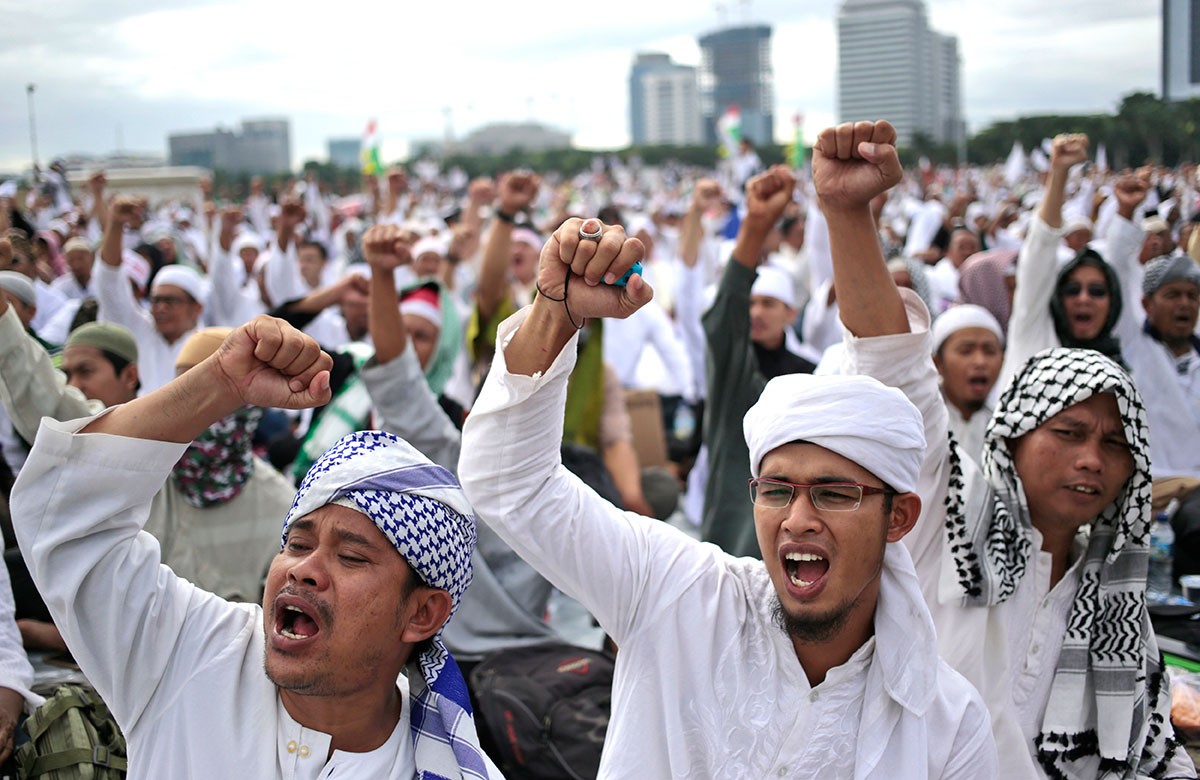 Muslim men shout "God is great" during a rally against Jakarta's minority Christian Governor Basuki "Ahok" Tjahaja Purnama who is being prosecuted for blasphemy, at the National Monument in Jakarta, Indonesia, Friday, Dec. 2, 2016. Several hundred thousands of conservative Muslims rallied in the Indonesian capital on Friday in the second major protest in a month against the minority Christian governor. (AP/Dita Alangkara)
Muslim men shout "God is great" during a rally against Jakarta's minority Christian Governor Basuki "Ahok" Tjahaja Purnama who is being prosecuted for blasphemy, at the National Monument in Jakarta, Indonesia, Friday, Dec. 2, 2016. Several hundred thousands of conservative Muslims rallied in the Indonesian capital on Friday in the second major protest in a month against the minority Christian governor. (AP/Dita Alangkara)
A
lot has been said about the Dec. 2 protest by those who supported and were against it. The proponents of the protest have argued that the action was purely motivated by religious sensibilities and not about the religion or ethnicity of non-active Jakarta governor Basuki “Ahok” Tjahaja Purnama, although back in 2014, the Islam Defenders Front (FPI) — one of the initiators of the National Movement to Safeguard the Indonesian Ulema Council’s Fatwa (GNPF-MUI) — had already rejected Ahok on the basis of his religion and ethnicity.
On the contrary, those who are against the 212 protest claim that the action was no more than political exploitation of religious symbols.
Two worrying trends about all this narrative and counter-narrative are, first, just how easy it is for the Indonesian Muslim communities to fall into the trap of using a massive number of supporters for protests and taking it as a claim of the righteousness of their action, and second, the absence of the voice of Muslim women during both the protests and within the myriad commentaries and counter-commentaries written about the protest. It seems like the largest Muslim protest in Indonesia has forgotten to include half of the ummah, the Muslim women.
Already I can hear the cliché counter-arguments that proponents of the protest might have against my opinion. “A lot of women, with their kids and family, were marching with us in the 212 protest,” or “You are just criticizing us from far away, you weren’t in the field and didn’t see for yourself how the women marched with us.” It’s true that women marched to the National Monument (Monas) on Dec. 2 and I was not there to see them in person.
But one does not need to be in the field to see that the presence of most women in the protest was to affirm the patriarchal politico-religious narrative at best, and to serve as child caretakers at worst.
The protest structurally and systematically rejected the presence of Muslim women within its circle of narrative. Structurally speaking, the protest was centered on the Friday prayer, a specific kind of public worship in which Muslim women not only in Indonesia but also around the world are discouraged from attending. This was proven when the prayer was about to start and the women were asked to move and give up their places for the men because the Friday prayer was supposed to be only about male Muslims and their “Islamic masculinity”.
(Read also: Islamic feminism matters)
In addition, when one looks at it from the historical perspective, the Friday prayer also functioned as political and military mobilization in medieval Islam, with no room whatsoever for the existence of Muslim women.
Systematically speaking, the protest was organized by the GNPFMUI, which is dominated by vigilante groups. That being said, the logic of these vigilante groups is in full operation within the GNPF-MUI.
Narratives that the 212 protest was a form of “jihad”, that respect needs to be paid to the Muslim leaders and habib (and not to the mothers who dealt with their kids during the march under the scorching sun and — afterwards — the rain of Jakarta), and that the Muslim males who attended the protest deserved to be praised due to their peaceful conduct (despite the fact that peaceful conduct is a responsibility, not an option, for every protester around the world), were built upon the false claim that, since it is natural for the Muslim guys to be violent, the peaceful 212 protest must be a spiritual miracle that showed God’s agreement with the systematic violence that the majority Muslims in Indonesia have imposed upon the country’s religious minorities.
On top of all of that, the most unfortunate misogynistic element that occurred during the protest was shown in several sexual assaults against women who happened to be in the proximity of the protest site and who were deemed to be not wearing “Islamic clothing” by some male protesters. Though, seeing the narratives centered on the protest, one would not be surprised that sexual assaults were in order.
Here is the largest gathering of “mujahids” who came to prove their loyalty to their religion by banishing a minority governor. They came to prove that they are the guardians of fragile Islam. The whole depiction of the protest was centered on the number of protestors and muscular expression of jihad. Each and every sense of masculinity in the protest was buttressed by the legitimacy of the ulema and the sense of divine justification to the supremacy of men over women.
The women in “non-Islamic” clothing, who were victims of the sexual assaults, were seen as toxic appearances within the holier-thanthou protest to defend the Quran, and thus they needed to be “punished” by sexist and misogynistic slurs.
More than that, these women were also there to be “offerings” for these mujahids. They were there as sexual objects because, after all of the shouting and marching in defense of Islam, these mujahids felt that they deserved instant sexual gratification in the form of women in short skirts and tight clothing.
Post-212 protest, it is very unfortunate that there are people who even think that the FPI vigilante group might be able to lead Indonesian Muslim communities to glory (whatever that means). But even if this is true, it is proven that conservative Indonesian Muslims are far from ready to share the stage with Muslim women and that any Islamic movement that alienates the presence of women within its midst is doomed to fail.
---------------
We are looking for information, opinions, and in-depth analysis from experts or scholars in a variety of fields. We choose articles based on facts or opinions about general news, as well as quality analysis and commentary about Indonesia or international events. Send your piece to community@jakpost.com. For more information click here.


